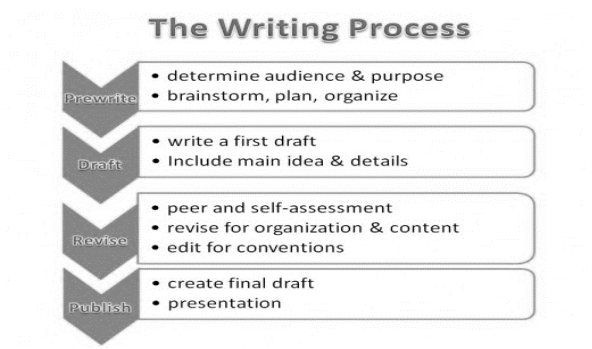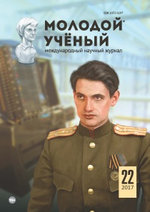Writing has always been seen as an important skill in ESL classes. It is the area in which learners are expected to be offered adequate time to develop their writing skill. This is certainly an important element of learning English as a second language.
The process of writing means planning, writing a first draft, revising and presenting. Writing is a sequence of differentiated and recursive processes» [1].

Fig. 1. The Writing Process
First of all, we must define what kind of writing should students do? Like many other aspects of English language teaching, the types of writing we get students do will depend on their age, interests and level. We can get beginners to write simple poems, but we probably will not give them an extended report on town planning to do. When we set tasks for elementary students, we will make sure that the students have or can get enough language to complete the task. Such students can write a simple story but they are not able to create a complex narrative. It is all a question what language the students have at their group and what can be achieved with this language. The models we give students to imitate should be chosen according to their abilities.
In general, we will try to get students writing in a number of common everyday styles. These will include writing postcards, various kinds of letters, filling in forms such as job applications, writing narrative compositions, reports, newspaper and magazine articles etc. We may also want to have students write such text types as dialogues, play scripts, advertisements or poems, of course if we think these will motivate them.
Another factor, which can determine our choice of writing task, is the students’ interests. Getting into consideration, their directions or field of their future specialties we can choose appropriate tasks for special deals. If we have mixed group students of different specialties, their interests will not be so easy to pin down. At this point, we will choose writing tasks, which we think, are generally useful but which, more importantly, they are likely to enjoy doing. For example, students of technical universities may never have a need to write a scene from a soap opera, but they might enjoy by doing it, so it is worth doing.
There is no limit to the kinds of text we can ask students to write. Our decisions though will be based on how well students know the language, what their interests are and what we think will not only be useful for them but also motivate them as well.
This cyclical process when composing texts make writers move forwards and backwards: planning, actual writing on paper and revising, all these sub processes interacting with one another in contrast to the traditional linear step-by-step procedure of writing where the emphasis was given to the student ́s mastery of the code and certain subject matter. Although writing in general involves various stages, in reality however, the process of composing is not linear and writers do not follow a systematic sequence of rehearsing (planning), drafting (actual writing on paper) and revising but it is a recursive activity. Writing has been described as a recursive process, in which the writer plans, translates ideas into language, and reviews what has been written. As we have already mentioned previously, writers that are more skilled pay more attention to content and organization, while weaker writers are more preoccupied with the mechanics of writing, especially spelling, punctuation and grammar. Good writers are found to use a longer pre-writing period than average writers do. The recursive nature of writing sees a writer moving between drafting and revising with stages of replanning in between and this going back and forth makes writing a process that leads to clarity». As a process, writing does not move in a straight line from conception to completion: not all planning is done before words are put on paper; all the words are not on paper before writers review and revise. Writers move back and forth among these sub processes» [2].
As Shaughnessy cited in Zamel “Writing can be explained as a process of exploring our own thoughts, the record of an idea developing. It is a process whereby an initial idea gets extended and refined» [3].
Writing is a complex process and can lead to learner frustration. As with speaking, it is necessary to provide a supportive environment for the students and be patient. Below mentioned activities will help to teach writing and make the process of writing more effective.
Graphic organizers are a really good way to get students planning what they are going to write before they actually begin the task of writing. Graphic organizers are a visual representation of the information they would like to include in their writing. Some examples are:
Venn diagram — These show relationships between two or more things. Venn diagrams are great for showing similarities and differences.
T-Chart — Explores a topic with opposing views. Examples could include: likes/dislikes, before/after and advantages/disadvantages.
KWL— A way to record student’s knowledge on a topic before you begin and at the end of the topic. K-what students KNOW; W-what students WANT to know; and L-what students LEARNED.
PMI — Used to record different views. P-Plus, M-Minus, I-Interesting. This organizer can be used by students when giving feedback to other students about their work.
Pass it on- this activity can be used in small groups. It is best to use a template for this to guide how much students write. Each student has a turn to write an introduction. They then pass this on to the next student in the circle. Students read the introduction and then write the middle of the text. Finally, with the last pass around the circle, each student reads the introduction and middle and then writes a conclusion. The writing is passed back to the original writer to read and share with the group.
Rapid/Rocket writing- The idea behind this is to get students to write down as much information as they can on a topic in a given time, without focusing on fixing spelling, grammar or other mistakes. Students should be provided with a time limit (such as 5 minutes).This could be the beginning of a series of lessons where the teacher focuses on different parts of the rapid writing, such as cohesion, spelling, punctuation and grammar.
Drawbacks- It takes a lot of time and effort to write, and so it is only fair that student writing is responded to suitably. Positive comments can help build student confidence and create good feeling for the next writing class. It also helps if the reader is more than just the teacher. Class magazines, swapping letters with other classes, etc. can provide an easy solution to providing a real audience.
Teachers should be facilitators and are responsible of creating the best possible conditions for learners.
References:
- Flower and Hayes, A Cognitive process of Theory Writing, National Council of Teachers of English, 1981.- p.59–74
- Humes, A. Research on the composing process: Methodology, results, and limitations. Washington, DC: National Institute of Education,1982.p.-56
- Shaughnessey, Mina P. Errors and Expectations- guide for the teacher of basic writing. Oxford University Press, 1977.-p.-234.
- http:// littlemissteacherkl.blogspot.com







